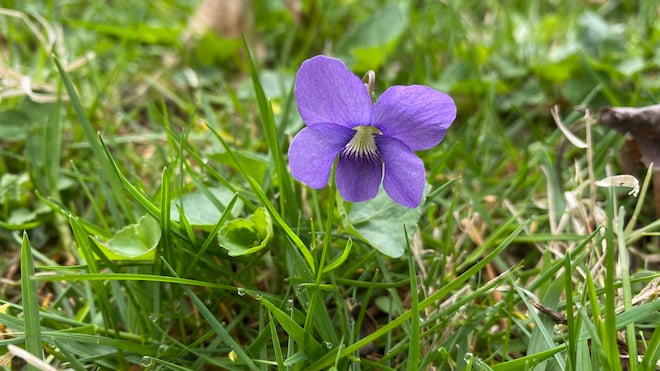This week: Is a native lawn possible?
Happy New Year!
This week, we're reaching into the mailbag and answering a reader question. She writes: Are there any native plants that can be used as a lawn substitute (or incorporated into a lawn), while keeping everything to a 4- or 5-inch height?
This inquiring mind can’t go full-on meadow but wants a more ecologically friendly lawn.
There are a few ways to improve a lawn with native plants:
- Incorporate native plants into your traditional turf grass.
- Install patches of native plants in place of traditional grass.
- Plant a part-native low-mow fescue grass mix.
Let’s look at each in detail, from least effort to most effort.
Adding Native Plants to Traditional Grass

There are several reasons to keep traditional grass: first and foremost, it can handle foot traffic. It’s great for paths and play areas for kids, grown-ups, and pets. You can’t exactly throw a backyard cookout or play an (easy) game of catch if everybody’s trampling around a meadow!
That said, you don’t need to have a “perfect” lawn. You can encourage the pre-existing native seed bank to germinate low-growing native plants.
To encourage pre-existing natives to appear, stop treating your lawn with weed-and-feed products (I already know you aren’t weed-and-feeding!) and set your lawn mower blades to cut no lower than 3 inches high (the taller the better). High mower blades will help small native plants flower and go to seed, creating new generations of plants. If you’re worried about non-native weed control, I’m sad to say the solution is manually cutting them at the base or digging them out by hand.
Anyway, you might start to notice some of these native plants popping up:
- Common Violets (Viola sororia)
- Spring Beauty (Claytonia virginica)
- Wild Strawberry (Fragaria virginiana)
- Quaker Ladies (Houstonia caerulea)
You can also buy seeds for these from places like Prairie Moon or Prairie Nursery and add them to your grass. Be patient, though! Most of these will take a full year or two to flower.
Side note: Cornell University is studying a native lawn replacement. You can learn more about their progress here.
Install Patches of Low-Growing Native Plants

Not every native plant can tolerate frequent trampling, but you can increase the odds of survival by planting patches in under-used spots.
Observe your lawn. Are there places where people rarely go? Perhaps there is an area beside the air conditioning unit, next to the house, or along a row of shrubbery. Consider removing the grass from these spots and planting clumps of low-growing natives instead.
Swaths of Creeping Phlox (Phlox subulata), Blue-eye Grass (Sisyrinchium species), or Wild Ginger (Asarum canadense) make lovely low-growing groundcovers that will bounce back from the shock of the annual AC tune-up or gutter-cleaning event.
If you’d like something that is more grass-like, consider Sedge (Carex species). Mt. Cuba Center did an exhaustive review and rated each by sun exposure, soil type, durability, and more.
Replace the Lawn with Low-Mow Fescue Mix

Just can’t give up that turf look? While it's high-effort to start, replacing your lawn with a semi-native low-mow mix could be for you. I replaced my regular grass with Eco-Grass a few years ago. It held up well once it was established, and requires as much maintenance as I care to give it. You can mow to 3 or 4 inches for a tidy look or let it flop and just give the blades of grass an occasional trim with a weed-whacker or a mower. While it is not a 100% native solution, these fescues have a deeper root system than traditional grass for better stormwater infiltration and will also cut down on natural resources because they require less maintenance.
The low-mow mixes sold by native plant nurseries are typically a mix of the following fescues but always check the label and do some research:
- Festuca rubra var. rubra - native throughout most of the U.S.
- Festuca rubra - native to scattered parts of the U.S.
- Festuca ovina - native to Canada and Western U.S.
- Festuca brevipila - non-native
- Festuca rubra subs. fallax - non-native
If you give any of these a try, let me know how it goes!
Elsewhere:
Learn about native plants that put on their red colors for the festive season in this post from the Pennsylvania DCNR Good Natured Blog.
Have a great week!
Julie